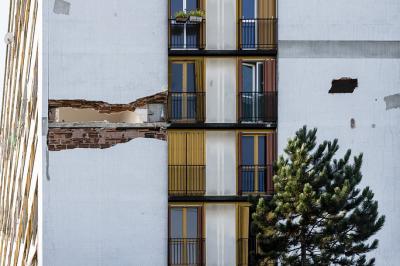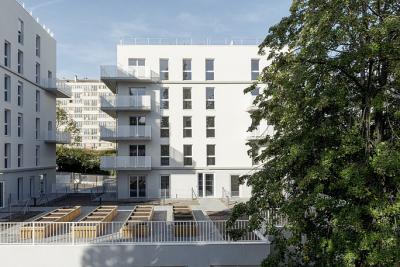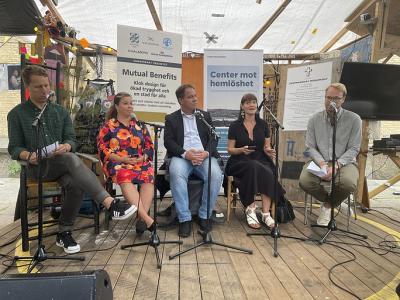Housing is fundamental to our everyday health, wellbeing and dignity. Yet, according to data from Eurostat, as cited by the European Parliament, EU house prices have been rising over the last 10 years. Furthermore, more than 1 in 10 households in EU cities now spend over 40% of their disposable income on housing.
How can local urban governments respond? For inspiration, here are six practical solutions used by EU towns and cities to improve access to safe, adequate housing in their communities. All are among the latest sustainable urban development solutions officially selected as URBACT Good Practices – not only for their local impacts, participatory and integrated approaches but also their transferability to other cities.
Read on for highlights of each practice, along with some takeaways on improving housing in your own municipality, whatever its size.
Bringing stakeholders together to tackle substandard housing
A pro-active, multi-stakeholder approach is essential to improve living conditions where housing is degraded, unhealthy or unsafe. The following three solutions bring together diverse actors – from private owners to public prosecutors – to tackle substandard housing while promoting social inclusion and environmental sustainability.
#1 – Clichy sous Bois, Grigny, Mantes la Jolie and Villepinte (FR)
This Framework for the improvement of private housing focuses on private condominiums in four Paris suburbs, all suffering from financial and technical difficulties, substandard housing and degraded public spaces.
The initiative is carried out by the Etablissement public foncier d’Île-de-France (EPFIF), within a local framework for the improvement of private housing (ORCOD-IN). It involves short-term interventions to improve living conditions, but also longer-term transformation; for instance:
Demolishing the most run-down condominiums, or transforming them into social housing, refurbishing public facilities, and greening public spaces.
Improving and diversifying the economic and commercial fabric.
Methodological support and grants for the condominiums to remediate financial difficulties and improve energy efficiency.
Social support to owner-occupiers to help them deal with debt and administrative problems, rehousing in social housing if needed.
Partnership-based governance is organised around technical and steering committees, involving many stakeholders: from private owners, condominium management boards and shopkeepers to state agencies, social housing organisations, the tribunal and the police, city councils, agglomerations, départements and the region.

#2 – Schaerbeek (BE)
Schaerbeek’s Housing investigation system (ILHO), involves diverse partners combating unsafe living conditions and landlord exploitation, improving tenants' quality of life. In nine years it has benefited 1 000 households in 137 buildings.
Coordinated by the urban planning and population departments, ILHO pools data from various sources including police, urban planning and tax authorities. In a cross-departmental approach, the police inform urban planning of tenant numbers and accommodation status, and the population department shares details of unauthorised housing registrations.
This enables ILHO to identify housing with inadequate ventilation, high humidity, and other serious health and safety problems. Officers visit prioritised homes – with the urban planning department, police and other authorities as necessary – enabling the Public Prosecutor's Office to pursue criminal actions against landlords. ILHO also supports landlords in renovating inadequate buildings and helps tenants with social and legal needs.
So far, other neighbourhoods in Brussels have been inspired by Schaerbeek to adopt similar models, including Ixelles and Anderlecht, with its new ‘Dignity system’.

#3 – Garges-lès-Gonesse (FR)
The Tool for monitoring housing tackles substandard condominium housing. Recommended, but not required, by the national government, it tracks negative developments in large housing complexes, identifies necessary interventions and provides tailored solutions for struggling condominiums.
Using this tool, Garges-lès-Gonesse studied 4 800 housing units in 64 condominiums, 41 with over 55% unpaid dues. Actions included safeguard plans, a dedicated operational programme, and thermal renovation works – with a 45% average energy gain.
Owners are involved throughout, alongside diverse stakeholders, with strategic partnerships mobilising renovation and urban development funding. The city and prefecture work in partnership, with prefectural orders issued for violations under the Public Health Code on substandard housing. Between 2021 and 2023, fines of over EUR 100 000 were imposed for such violations.
What’s the takeaway for your city?
Each practice has effectively addressed environmental, economic and social challenges related to housing (e.g. substandard housing, overcrowding, exploitation of vulnerable residents). Whether private or publicly owned, a systematic, multi-stakeholder approach is vital, along with appropriate regulation, enforcement, and financial and legal tools.
This includes cross-sector partnerships to collect and share data on specific housing problems, and respond accordingly – in the short and long term.
In the case of practice #2, the ILHO team is already sharing its approach with other cities, for example, through the Association of Towns and Municipalities (Brulocalis).

Innovative models empowering residents and owners
Looking at the practices below, cities can sometimes benefit from thinking outside the box. Through innovative, sustainable approaches, cities are improving access to affordable housing – while also revitalising outdoor spaces, reducing climate impact, and boosting community development, inclusion and diversity.
#4 – Trnava (SK)
Public Space Revival revitalised public space in a housing estate through an open design competition and multiple rounds of consultation in an extensive participatory process. Elements include new green and blue infrastructure to increase eco-stability, and areas for inclusive activities such as a community garden, exercise and playgrounds for all age groups, and a publicly accessible school yard. Safety improvements include new public lighting, footpaths, and better social control mechanisms. Dozens of trees have been planted, and low maintenance areas introduced, including meadows for pollinators. There is also a stream and a bio-active pond.
Once a plain open space with minimal amenities, neglected paths, and unsafe urban furniture, the area is now a biodiverse, popular outdoor meeting place and a source of wellbeing for residents.
The model has since helped revitalise urban areas across Trnava, with three key principles: open design competition, participatory process, and compatibility with all main EU agendas.

#5 – Gothenburg (SE)
Smart design for increased security and a city for all uses place-based collaboration to improve experiences of security, making it possible to house individuals with complex conditions in regular residential areas.
The practice was developed in response to expensive, unsustainable strategies that push socially vulnerable groups towards the outskirts of cities, through hostile architecture, policing and regulation. It specifically includes the perspectives of socially vulnerable people when tackling urban development and security issues.
The practice features three key parts:
A model for place-based collaboration around supported housing, treating socially vulnerable people’s needs as equal to those of the wider public;
A functional programme for supported housing, guiding the city in its future acquisition of premises for socially vulnerable residents;
A review of the urban development process, piloting improved practices for including socially vulnerable groups in urban development.

#6 – Vienna (AT)
The property developers’ competition ensures the construction of innovative, sustainable, socially inclusive and affordable housing. The wohnfonds_wien ‘Fund for subsidised Housing and Urban Renewal’ invites both non-profit and commercial property developers to submit proposals, forming a project team with the architect of their choice.
Requests to build new social housing are evaluated by an interdisciplinary jury of experts who choose whether or not to recommend funding, based on quality criteria in four key categories:
Economy: Basic costs, total building costs, user costs and contract conditions.
Social sustainability: Suitability for daily life, cost reduction through planning, living in a community, housing for changing needs.
Architecture: Building and apartment structure.
Ecology: Climate-friendly construction that conserves resources, healthy and environmentally-conscious housing, and green outdoor spaces.
What’s the takeaway for your city?
Each practice in this section shows the value of innovative, participatory urban design in improving housing affordability, sustainability and inclusion.
Towns and cities across the EU can adopt and adapt these tools to meet their own priorities and challenges — empowering residents and owners to help improve quality of life, and build more resilient, dynamic communities.

Cities joining forces to solve Europe's housing crisis
Collectively, the practices showcased here illustrate the power of cities to help ensure everyone can access housing that is affordable, safe and sustainable.
Explore the full range of URBACT Good Practices, tried and tested on tackling urban challenges as diverse as climate action, energy efficiency, mobility or social inclusion.
Is your city administration ready to join a network of EU cities adapting and adopting one of the latest 116 URBACT Good Practices? Find out about URBACT’s new call for Transfer Networks, running from 1 April to 30 June 2025. Join the online info sessions hosted by the URBACT Secretariat and ask your questions!


